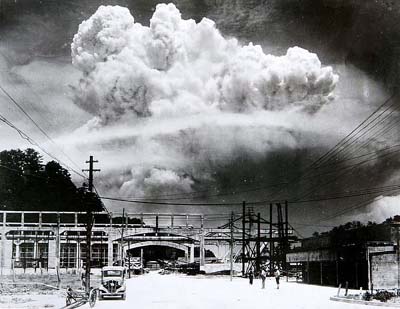
What are the stories we’re reading about Hiroshima and Nagasaki?
Eric Margolis
Tokyo: Nothing makes for a sales hook like an anniversary. And as this year marks 75 years since the dropping of the atomic bombs on Hiroshima and Nagasaki, the English books market responded with nearly a dozen histories, treatises, explorations and poetic renditions of the atomic bombings in 2020.
What we read about such monumental historical events define and redefine our understanding of the world. Consider two major recent accounts: conservative television host’s Bill O’Reilly’s “Killing the Rising Sun: How American Vanquished World War II,” (2016) and historian Paul Ham’s “Hiroshima Nagasaki: The Real Story of the Atomic Bombings and Their Aftermath” (2010).
The first follows American soldiers, generals and scientists as they develop the atomic bomb; the second tells the stories of 80 Japanese survivors. The first casts Americans as the heroes and Emperor Hirohito as the villain; the second argues that the bombings had little impact on the eventual outcome of World War II. Fittingly, O’Reilly’s book features Douglas MacArthur and Harry Truman in front of the iconic mushroom cloud on the cover; Ham’s features a Shinto torii gate standing in the aftermath.
These two opposing perspectives represent the extremes that English-language narratives about the atomic bombings can reach. This year’s selection of books runs a similar gauntlet, proving that even 75 years later, the atomic bombings are very much what we make of them.
The Western conception of the atomic bombings was first shaped by Henry Stimson’s 1947 “The Decision to Use the Atomic Bomb.” James Orr, associate professor of East Asian studies at Bucknell University, says that Stimson’s writing established the idea that bombing Hiroshima was the least abhorrent choice between using the devastating weapons and a deadly invasion.
“(The bombings) came to be seen as a necessary act that ended a horrific war, and perhaps saved more lives than it took,” Orr told The Japan Times.
Different historical movements injected mistrust into the Stimson narrative, such as the Vietnam War and the 1995 Enola Gay Exhibit at the Smithsonian. But overall, Orr says the Stimson narrative still dominates.
“Last August, I participated in a discussion over social media among Japan scholars, and there was general agreement that Hiroshima and the Soviet Union’s entry into the war were both very important in getting (Japan) to surrender,” says Orr. “But later generations of Americans I have in my classes seem, on average, to be less invested in avoiding confronting the difficult questions about this particular use of a weapon of mass destruction.”
The American understanding of the bomb naturally contrasts with the common Japanese perspective, where students are taught primarily about the immense physical and psychological damages of the bombing. A revealing survey by Hiroshima University shows that nearly 80% of hibakusha either do or did resent the United States. And scholars around the world have not (and perhaps will not) come to a resolution about just how evil or necessary the bombing was.
This year’s book selection reflects that diversity. On the O’Reilly side of the spectrum, Fox News journalist Chris Wallace’s “Countdown 1945: The Extraordinary Story of the Atomic Bomb and the 116 Days That Changed the World” chronicles Truman’s journey toward the decision to drop the bomb, an account that “reads like a tense thriller,” according to The Washington Post. Military historian David Dean Barrett’s “140 Days to Hiroshima: The Story of Japan’s Last Chance to Avert Armageddon” portrays Japan’s leaders as militarist fanatics in its account of the war room drama inside the cabinets of the US and Japan.
Although this war drama perspective dominates American sales (Wallace and O’Reilly’s books were both massive bestsellers), humanitarian depictions of the suffering incurred by the bombings also have a long and notable literary history. Most notably, John Hersey’s 1946 “Hiroshima” tells the story of Hiroshima through the memories of survivors, and remains one of the most impactful and respected reports on the atomic bombings to this day. One book from this year, Lesley M.M. Blume’s “Fallout: The Hiroshima Cover-up and the Reporter Who Revealed It to the World” retells Hersey’s reporting and his attempts to reveal the truth of Hiroshima.
Surprisingly and perhaps disappointingly, no notable humanitarian accounts in the tradition of Hersey came out this year. But we did get to see the first English book on Sadako Sasaki, the young Japanese victim of the Hiroshima bombing who became a national icon by folding 1,000 paper cranes while in the hospital. “The Complete Story of Sadako Sasaki and the Thousand Paper Cranes,” written by Sue DiCicco and Sadako’s older brother Masahiro, gives “a glimpse into Sadako’s life and the horrors of war.
For a more objective perspective, The Manhattan Engineer District released a new edition of “The Atomic Bombings of Hiroshima and Nagasaki,” which presents the U.S. military’s report on the bombing and the aftermath with eyewitness accounts.
All in all, out of five top-selling books on Hiroshima published in English this year, two skewed conservative (Wallace and Barrett), one skewed liberal (Blume) and two neutral (DiCicco and Sasaki, and Manhattan Engineer District). The unfortunate truth is that we use Hiroshima to tell the stories we want to hear.
So it’s up to the reader to choose books that challenge our own assumptions — and to read them critically. If you never knew that the U.S. launched a suppression campaign to cover up the truth of the atomic bombings, read Blume. If you’ve never read eyewitness accounts of the bombing, read The Manhattan Engineer District. Seventy-five years after the bombing, we must question our own beliefs and aim for a more empathetic and truer understanding of history.